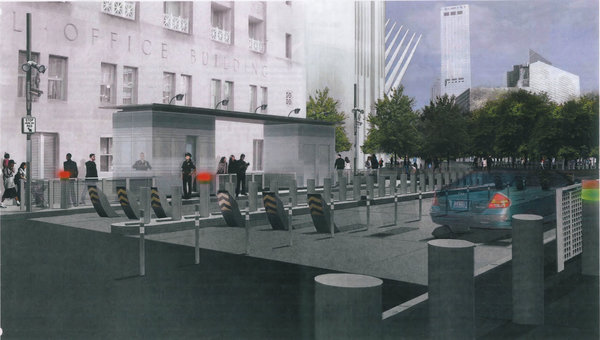By David W. Dunlap New York Times

A rendering of proposed security measures near the World Trade Center site that residents call onerous. New York Police Department
To the question, “How much security apparatus is needed on city streets?” the agencies charged with guarding public safety seem to answer, “As much as we say.”
Against the memory of two successful attacks on the World Trade Center and numerous foiled plots, no one wants to sign off on security measures that could later be breached or compromised, with a loss of life, limb and property. So barriers, gates, fences and checkpoints proliferate. Whether they are reasonable and prudent — or excessive results of worst-case thinking — is a matter often left unspoken.And that leaves the public with no meaningful way to assess the transformation of some city streets into obstacle courses.
Hoping to cast some light on the issue, a group of Lower Manhattan residents is preparing to sue the New York Police Department over its security plan for the World Trade Center, saying that the plan will leave the center in “fortresslike isolation” and the area around it “as impervious to traffic as the Berlin Wall.”
Chief among their objections, they said, was that the environmental impact statement about the plan “failed to explain and generally suppressed the N.Y.P.D.’s rationale for critical aspects of the plan based on a purported need for secrecy.”
The Police Department plans to close the streets in and around the trade center to normal through traffic. Vehicles would be screened before entering this zone, or “campus,” as the police call it. Some would be searched. Only those having demonstrable business at the trade center, or those previously certified as trustworthy, would be allowed in.
Drivers who regularly come into the secured zone could enroll themselves and their vehicles in a Trusted Access Program, although the police said that specific operational details of the program would not be released out of security concerns.
“The N.Y.P.D. has determined that the entire World Trade Center site is a potential target,” the department said in the impact statement.
To ensure that the campus is reasonably defensible, the police plan to ring the perimeter with three-foot-tall barriers, 11-foot-tall guard booths and long sally ports through which vehicles would pass for screening.
Pedestrians and bicyclists would be free to come and go, the police said, “although cyclists may be required to dismount to walk their bicycles through security stations.”
The measures are expected to be fully in place by 2015. The security plan was described in some detail in the 834 pages of the environmental impact statement that state law requires.
But the 12 residents and one shop owner who are suing the police, under the name of the WTC Neighborhood Alliance, said in their complaint, which is expected to be filed on Thursday in Supreme Court in Manhattan, that the impact statement was flawed by faulty analysis and its rejection of alternative measures. Six of the plaintiffs live on Liberty Street, within the heavily secured zone.
They include Mary Perillo, the leader of the ad hoc alliance and the communications director of the 9/11 Environmental Action group, who has lived opposite the World Trade Center for more than 30 years. They are represented by Daniel L. Alterman and Albert K. Butzel, an environmental lawyer who is known for contributing to the defeat in the 1980s of the Westway highway planned along the Hudson River.
They will ask the court to annul the plan and compel the police and other agencies to produce documents and records that “are bound to shed light on how the campus security plan was developed and with what considerations in mind.”
Responding to the impending lawsuit, the city’s Law Department issued a statement on Wednesday: “Car and truck bombs pose very real and serious risks. Indeed, the 1993 attack on the World Trade Center was a truck bomb, and the security plan guards against vehicle bombs by screening automobiles.”
“Pedestrians and bicyclists will be able to freely enter and move about the site,” the city’s statement continued. “The environmental review that is being challenged was a thorough and public process. Publicly available documents describe the plan in detail. Those suing also had the opportunity to express their concerns, which we responded to with a comprehensive environmental impact statement. It is vital that construction move ahead now.”
Acknowledging that security installations have “some visible presence on the streetscape,” the impact statement said the booths would be designed by Grimshaw, the architectural firm responsible for the city’s new bus shelters and newsstands, to keep the appearance “consistent with other street furniture.”
“The access needs of local residents and businesses were carefully considered,” the impact statement said. For instance: “Residents who need to travel through the security perimeter for access to their homes would have the option of enrolling themselves and their vehicles in the Trusted Access Program.”
To which Ms. Perillo said, in her affidavit: “I live in the City of New York — not ‘on campus’ or in a gated community. I do not want to prove who I am to come home to my own apartment.”

